 TiVo has announced that it plans to offer the first TV-based advertising “search solution” early next year.
TiVo has announced that it plans to offer the first TV-based advertising “search solution” early next year.
Starting in Spring 2006, TiVo’s new television search capabilities will, apparently, “enhance the TV viewing experience” by delivering targeted advertising to subscribers interested in viewing particular advertising categories.
Hotshot media and advertising agencies like Interpublic Media, OMD, Starcom Mediavest Group, The Richards Group and Comcast Spotlight have teamed up with TiVo to develop the product and help determine relevant categories of interest (cars, travel, telecommunications, and consumer packaged goods etc) as well as work out pricing models.
TiVo claim their new technology will allow companies to shunt on-demand, consumer targeted TV advertising to viewers without the limitations of traditional television media placement.
 With punters able to search for products by category or associated keywords, TiVo sees big benefits for advertisers (obviously) and punters looking for information on products or services.
With punters able to search for products by category or associated keywords, TiVo sees big benefits for advertisers (obviously) and punters looking for information on products or services.
The (ahem) “heightened viewer experience” offered by the new service is claimed to deliver “non-intrusive, relevant, interactive advertising, on an opt-in basis.”
TiVo subscribers electing to use the search service will be able to retain control over their “viewing experience” by creating a “viewer contributed profile” via the set-top box that will enable them to receive advertisements based on their interests (we wonder if there’s a “begone hideous advertisers forever” profile available?)
“TiVo is once again introducing to the TV landscape a new and innovative advertising solution that is intended to deliver an even better viewing experience for subscribers,” purred Tom Rogers, President and CEO of TiVo.
 Supping deeply on a morning brew of Buzzword Coffee, Tracey Scheppach, VP, Video Innovations Director at Starcom, enthused “The new TiVo application will provide both a needed platform for consumers to seek out relevant, searchable commercial content and an environment for advertisers to engage highly desirable and motivated consumers…it’s the first of its kind in the industry, and a platform that is clearly needed in this challenging advertising marketplace.”
Supping deeply on a morning brew of Buzzword Coffee, Tracey Scheppach, VP, Video Innovations Director at Starcom, enthused “The new TiVo application will provide both a needed platform for consumers to seek out relevant, searchable commercial content and an environment for advertisers to engage highly desirable and motivated consumers…it’s the first of its kind in the industry, and a platform that is clearly needed in this challenging advertising marketplace.”
The new service follows a successful interactive direct response advertising program on TiVo in August, where subscribers were able to respond to customised “calls to action” in select commercial spots.
Funnily enough, when we’re bombarded with advertising, the only “call to action” we get is to turn the ruddy thing off.
 US analyst firm JupiterResearch has surveyed the American digital music market, and discovered that the bulk of paying downloaders come from the 25-44 age group.
US analyst firm JupiterResearch has surveyed the American digital music market, and discovered that the bulk of paying downloaders come from the 25-44 age group.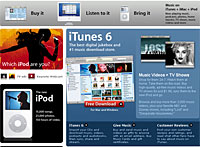 Online radio was seen to be a growing influence as were new tools like playlists and music blogs, but the report found that stronger integration with online radio and more promotion was necessary to make punters aware of these potentially powerful discovery tools.
Online radio was seen to be a growing influence as were new tools like playlists and music blogs, but the report found that stronger integration with online radio and more promotion was necessary to make punters aware of these potentially powerful discovery tools. The report blames non credit card-holding kids, claiming that 34 per cent of 15-24-year olds use file-sharing services, and this is “impacting the way they value music with many having little concept of music as a paid commodity.”
The report blames non credit card-holding kids, claiming that 34 per cent of 15-24-year olds use file-sharing services, and this is “impacting the way they value music with many having little concept of music as a paid commodity.” With a passion for creating new phones that is beginning to border on pathological, Samsung’s overworked designers have just revealed yet another new hi-tech handset, the SPH-V6800.
With a passion for creating new phones that is beginning to border on pathological, Samsung’s overworked designers have just revealed yet another new hi-tech handset, the SPH-V6800. There’s also a 1.3MP digital camera onboard with MPEG-4 video recording and MP3/AAC audio playback.
There’s also a 1.3MP digital camera onboard with MPEG-4 video recording and MP3/AAC audio playback. With the Samsung packing in wireless connectivity into its tiny 96.8 x 47 x 24.5mm dimensions, we could well be seduced by SPH-V6800 (if it ever makes it to these shores, of course).
With the Samsung packing in wireless connectivity into its tiny 96.8 x 47 x 24.5mm dimensions, we could well be seduced by SPH-V6800 (if it ever makes it to these shores, of course). Google is testing a potentially lucrative sales tool that allows users to ring up advertisers located through a Google search – for free.
Google is testing a potentially lucrative sales tool that allows users to ring up advertisers located through a Google search – for free.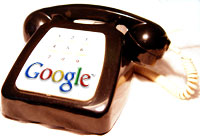 Moreover, they claim that the number will be blocked from the advertiser during the call, with Google promising to delete the number from their servers after a short period of time.
Moreover, they claim that the number will be blocked from the advertiser during the call, with Google promising to delete the number from their servers after a short period of time. Broadband adoption in the UK may soon be reaching its peak, according to a new report from Datamonitor.
Broadband adoption in the UK may soon be reaching its peak, according to a new report from Datamonitor. Although we’re nearly broadbanded out in Europe, the report sees excellent opportunities for growth in less mature markets.
Although we’re nearly broadbanded out in Europe, the report sees excellent opportunities for growth in less mature markets. LG Electronics’ PR department clearly don’t believe in a day of rest because Sunday saw them busily announcing the impending release of their LG PM 80, a PDA capable of receiving T-DMB (terrestrial digital multimedia broadcasting).
LG Electronics’ PR department clearly don’t believe in a day of rest because Sunday saw them busily announcing the impending release of their LG PM 80, a PDA capable of receiving T-DMB (terrestrial digital multimedia broadcasting). The actual device, presented here in the traditional manner by near-ecstatic Korean ladies (if only we got so much unbridled joy from our gadgets) follows the traditional PDA form factor, with the addition of an old-school pull out aerial for TV reception.
The actual device, presented here in the traditional manner by near-ecstatic Korean ladies (if only we got so much unbridled joy from our gadgets) follows the traditional PDA form factor, with the addition of an old-school pull out aerial for TV reception. As ever, the Koreans will get to play with this device for ages before we even get a peek at it – if they don’t decide to keep it to themselves for ever, of course.
As ever, the Koreans will get to play with this device for ages before we even get a peek at it – if they don’t decide to keep it to themselves for ever, of course. For techie-obsessives like the Digital Lifestyles crew, keeping connected when we’re away from home is right up there with finding a roof over our heads, so when we went off to New York, we made sure we packed our Sony laptop and Wi-Fi enabled smartphone – even on holiday.
For techie-obsessives like the Digital Lifestyles crew, keeping connected when we’re away from home is right up there with finding a roof over our heads, so when we went off to New York, we made sure we packed our Sony laptop and Wi-Fi enabled smartphone – even on holiday. One rather unfortunate side-effect of all this free connectivity was that once-bustling cafes turned into conversation-free libraries, with rows of transfixed surfers staring intently into their screens, with the silence only broken by intermittent bursts of keyboard activity.
One rather unfortunate side-effect of all this free connectivity was that once-bustling cafes turned into conversation-free libraries, with rows of transfixed surfers staring intently into their screens, with the silence only broken by intermittent bursts of keyboard activity. On the street, one handset seemed to be stuck in almost every New Yorker’s hand: the Palm Treo 750. They love the phone!
On the street, one handset seemed to be stuck in almost every New Yorker’s hand: the Palm Treo 750. They love the phone! The digital rights campaigning group, Open Rights Group, reports that the music industry is lobbying MEPs to co-opt the EU Data Retention legislation currently being debated by the European Parliament.
The digital rights campaigning group, Open Rights Group, reports that the music industry is lobbying MEPs to co-opt the EU Data Retention legislation currently being debated by the European Parliament. Coupled with the upcoming IPRED2 legislation (which creates new, Europe-wide criminal offences for intellectual property infringement), campaigners fear that we could end up with a situation where the music industry would be able to pursue criminal court copyright prosecutions entirely at the cost of the taxpayer.
Coupled with the upcoming IPRED2 legislation (which creates new, Europe-wide criminal offences for intellectual property infringement), campaigners fear that we could end up with a situation where the music industry would be able to pursue criminal court copyright prosecutions entirely at the cost of the taxpayer.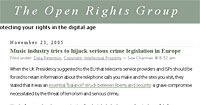 Ian Brown, of the Open Rights Group (not the Stone Roses), said: “The British government claimed that Data Retention was essential in the fight against terrorism and serious crime, but it has now become clear that groups with commercial interests have their eye on the same data. Charles Clarke cannot continue to pretend that this legislation has been drafted purely for reasons of national security.”
Ian Brown, of the Open Rights Group (not the Stone Roses), said: “The British government claimed that Data Retention was essential in the fight against terrorism and serious crime, but it has now become clear that groups with commercial interests have their eye on the same data. Charles Clarke cannot continue to pretend that this legislation has been drafted purely for reasons of national security.” P2P network, BitTorrent has signed an agreement with the Motion Picture Association of America to collaborate on stopping Internet piracy.
P2P network, BitTorrent has signed an agreement with the Motion Picture Association of America to collaborate on stopping Internet piracy. “BitTorrent Inc. discourages the use of its technology for distributing films without a license to do so. As such, we are pleased to work with the film industry to remove unauthorised content from BitTorrent.com’s search engine,” he added.
“BitTorrent Inc. discourages the use of its technology for distributing films without a license to do so. As such, we are pleased to work with the film industry to remove unauthorised content from BitTorrent.com’s search engine,” he added. The MPAA claims that the film industry lost $3.5 billion to movie piracy last year, with a recent study predicting the figure to jump to $5.4 billion this year. The MPAA claim these losses are excluding revenue lost through online file-swapping, so the true figure could be even higher (although other will say the figures are already gloriously exaggerated).
The MPAA claims that the film industry lost $3.5 billion to movie piracy last year, with a recent study predicting the figure to jump to $5.4 billion this year. The MPAA claim these losses are excluding revenue lost through online file-swapping, so the true figure could be even higher (although other will say the figures are already gloriously exaggerated).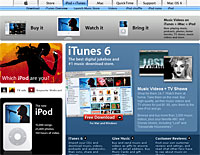 Apple’s iTunes online store has been ranked the seventh-largest music retailer in the US in the third quarter, charging into the top 10 for the first time.
Apple’s iTunes online store has been ranked the seventh-largest music retailer in the US in the third quarter, charging into the top 10 for the first time. Already eating iTunes’ dust are big names like Tower Records and Borders, reflecting music fans’ growing passion for online music.
Already eating iTunes’ dust are big names like Tower Records and Borders, reflecting music fans’ growing passion for online music.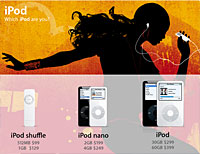 Combined revenue from the iPod, Apple’s fastest- selling product, and iTunes music accounted for a massive 40 percent of sales last quarter, up from 27 percent a year earlier.
Combined revenue from the iPod, Apple’s fastest- selling product, and iTunes music accounted for a massive 40 percent of sales last quarter, up from 27 percent a year earlier.